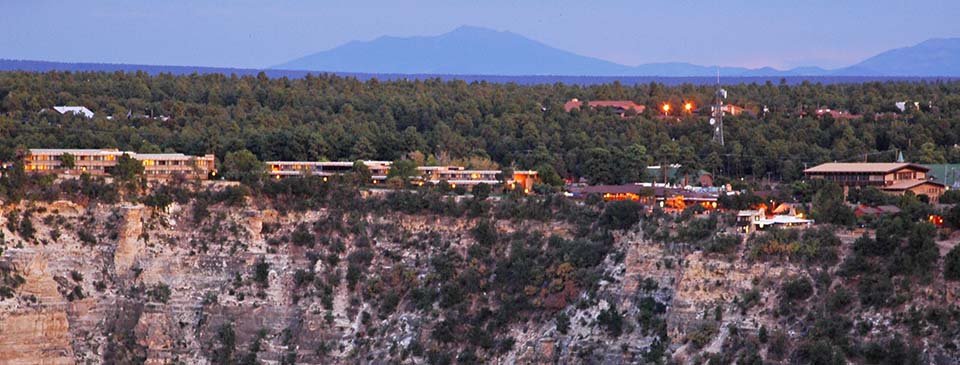
What if your trip to Grand Canyon National Park during this 2016 Centennial is not quite what you expected? Let's pretend for a minute that from I-40, Flagstaff or Williams, you have the choice of FOUR main roads to the South Rim, at least one of them a four-lane highway. Then there is the railroad, running several trains a day. On the Rim, you can drive from Desert View in the east, all the way through the Village, to Hermit's Rest and way out along the Rim to Supai on a paved road. There are hotels and amusements the entire way, visible across the side canyons from the road. There is noise, and smog from the cars and buses affecting the sunset views.
Yikes, there is even a tram system that takes visitors down to the river and back all day long, a fifteen minute ride one way. Lunch on the Colorado, anyone? You would FIND YOUR PARK alarmingly developed. In fact, it might look a lot like the cluster surrounding a major ski area.
It's been one hundred and forty seven years since Major John Wesley Powell sat proudly (some would say crazily) in his wooden chair, lashed to the top of his dory, and blasted through the rapids in what would become GCNP. It was 1896. His account of that voyage was not just a scientific document, but a romantic adventure story that captivated the imagination of many. Wouldn't you know, some of them had their imaginations fired by business success and wealth.
By the early 1900s, there really WERE at least four roads! - and the railroad - from Flagstaff to here. Though rutted wagon trails, they led up the Coconino Plateau to the Canyon east and west, and many people came a long way to see this wonder. The Village area was generally the same size and shape as today, yet more tourist expansion and mining stretched thinly across the rim for 30 miles, slowly dying or already abandoned to the wind and sun.
The fortuitous circumstances that led to the compact and organized accommodations at Grand Canyon Village came about during a series of ruthless economic battles between the Santa Fe Railroad and its associates and the handful of smaller entrepreneurs. Bill Bass ran tourist trips that brought Zane Grey and the painter Thomas Moran to the Canyon in the 1890s; he used the scam of staking mining claims to scenic areas to protect his tourism business. When in 1990 the railroad moved in, it not only bankrupted Bass, but deliberately built structures that blocked ones access to competing businesses including Kolb's photography studio and Verkamp's curio shop. It brought most of the water to the area - and refused to share it with competitors! Ralph Cameron claimed the Bright Angel trailhead and charged a dollar for every mule rider. Lawsuits flew. As he was elected County Board Chairman, he was able to make up his own laws and flout the railroad for seven years. It finally constructed the El Tovar in 1902 and doubled the amount of guest rooms in the Village while upping the ante on elegance.
The relentless railroad found a willing partner in the Forest Service, which had jurisdiction over the Grand Canyon when it became a Monument, and who also had a pro-development mindset. Expansion in those years was viewed as always positive. After the 1919 formation of the National Park itself, the two entities worked together as well, as visitation escalated. The Park Service had zoning and architectural control and the Santa Fe had the money;together they made the decision to focus on the Village rather than stretch out laterally along the South Rim. While financially advantageous for the Santa Fe, this agreement also enabled the Park Service to begin effective stewardship of the significant resource here. Accepting the Village as the railroad's investment opportunity let the Grand Canyon National Park focus on the rest of its responsibilities.
Those tough-minded small businesses are still here in various forms in the Village, forming a fascinating artistic, cultural, and historic backdrop to the magnificent view. Farther out to the east and west, the out-of-business places have crumbled to dust, becoming homes for wildlife. Remarkably, there is less developed area on the Rim than there was in 1920!
Visualize all the miles from Desert View to Hermit's Rest looking like the Village.As you enjoy the quiet walk on the Rim trail, between bus stops or carefully sited Park Service buildings, or hike down the switchbacks into the rocks and look back, it's hard to imagine - given the current level of enthusiasm for visiting here - that it could have turned out much better.Return to Inspiration Point Blog Index Page.
This blog is meant to encourage awareness and thoughtfulness about the Grand Canyon, one of our most precious resources. It is not merely a story of what happens or has happened here, not a cookbook for what you should make of it yourself, but more an example of the many-faceted inspiration the Canyon nurtures in an artist, perhaps in you. Indeed, inspiration may be the Canyon's greatest resource. These words are sincere, my own take on this world, deliberately non-academic and directed toward users of social media. In no way does it represent the policies or opinions of the National Park Service, although it is done under the auspices of that entity, but is offered in gratitude, with my respect and admiration for these soldiers of conservation. George H. Jacobi 2016
